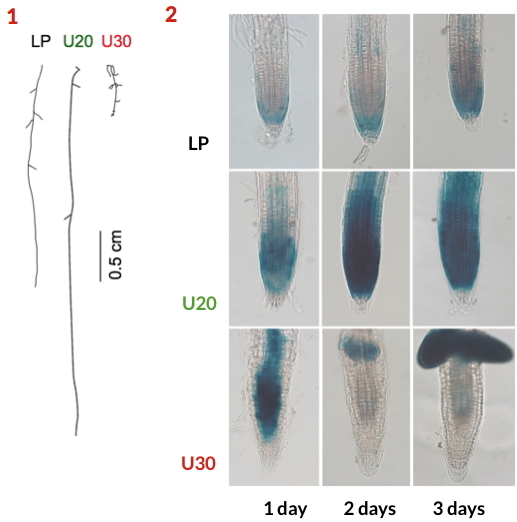Uranium is naturally present in the environment. It can be redistributed by mining, military and agricultural activities. This radionuclide, which is chemotoxic for all living organisms, can accumulate locally at concentrations that present potential risks for agrosystems and human health. Indeed, even though it is not essential for plants, uranium is absorbed from the soil, incorporated into the biomass and thus enters the food chain. Understanding the physiological, biochemical and molecular mechanisms that control the response and adaptation of plants to uranium-induced stress is a prerequisite for improving food safety and selecting phytoremediation-adapted species.
We showed that the development and the architecture of Arabidopsis thaliana roots are highly modulated in response to uranium in a dose-dependent manner.
At a sub-toxic dose, uranium stimulated the apex mitotic activity, resulting in improved primary root growth and reduced secondary root formation. At higher doses, the radionuclide completely inhibited the elongation of the primary root and increased the formation of secondary and higher-order lateral roots. These effects are related to a modulation of mitotic activity at the root apex, together with the synthesis of reactive oxygen species and nitric oxide, whose accumulation causes cell death at toxic level of uranium. These changes were associated with the disruption of the transport and distribution of the hormone auxin in the roots. These events were correlated with the accumulation of two defense polymers, callose and lignin, located in the cell wall. The synthesis of these compounds probably limits the diffusion of the toxic element in the root (inhibition of cell-to-cell communication and cell wall stiffening). In addition, this study showed that the initial events in the response to uranium stress are related with phosphate depletion and a redistribution of iron in root tissues. These results showed that part of the radionuclide effects is linked with the signaling cascade of phosphate sensing in the root apex. Other mechanisms responsible for uranium toxicity are likely related to perturbations of iron homeostasis (competition between uranium and iron for the binding to common ligands) and to direct effects of the radionuclide on cellular targets, which remain to be identified.
